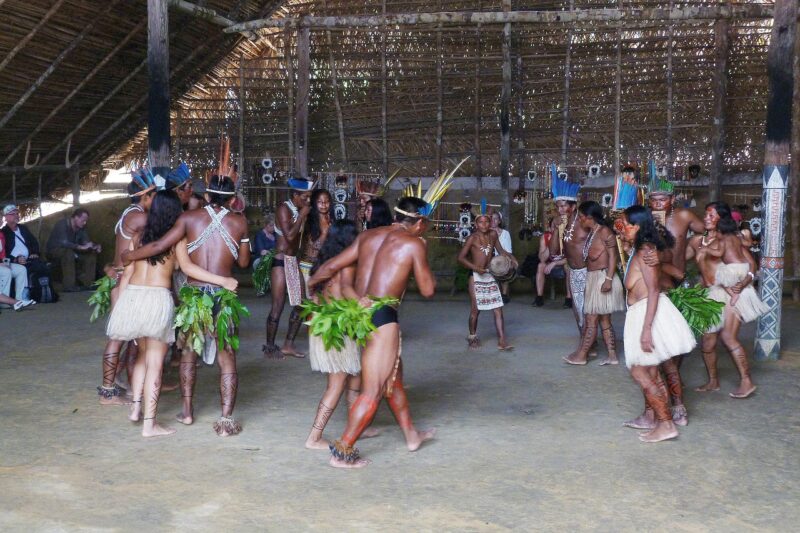Why the Amazon Rainforest Is Called Earth’s Lungs
November 16, 2024

The Amazon rainforest, often referred to as the “lungs of the Earth,” is a vast and intricate ecosystem that plays a crucial role in regulating the planet’s climate and air quality. Spanning across several countries, including Brazil, Peru, Colombia, and Venezuela, the Amazon is home to an astonishing variety of flora and fauna, many of which are found nowhere else on the planet. In this article, we will delve into the reasons why the Amazon rainforest has earned this title and its importance to the global environment.
1. The Mechanism of Photosynthesis
The title “lungs of the Earth” comes from the Amazon rainforest’s incredible ability to absorb carbon dioxide (CO2) and release oxygen (O2) through the process of photosynthesis. Plants utilize sunlight to convert CO2 from the atmosphere into oxygen, a fundamental element for life on Earth. This process is essential for:
- Air Quality Improvement: The Amazon rainforest produces approximately 20% of the world’s oxygen, making it a vital source for maintaining the quality of air we breathe.
- Carbon Dioxide Absorption: The trees and plants in the Amazon act as significant carbon sinks, absorbing CO2 and helping mitigate climate change and global warming by reducing greenhouse gases in the atmosphere.
Thus, the Amazon rainforest serves as a powerful ally in the fight against air pollution and climate change, functioning similarly to how human lungs filter air, making it essential for our survival.
2. Biodiversity: A Hotspot of Life
The Amazon is one of the most biodiverse regions on the planet, containing an estimated 390 billion individual trees and over 16,000 species. This rich biodiversity contributes to the planet’s resilience and its capacity to adapt to environmental changes. The variety of species in the Amazon provides numerous benefits:
- Ecosystem Stability: Biodiversity enhances ecosystem stability, ensuring that the rainforest can recover from disturbances such as diseases, fires, and other natural disasters.
- Medicinal Resources: Many plants found in the Amazon have medicinal properties and are used in traditional medicine and modern pharmaceuticals. The potential for discovering new medicines is significant, as many species remain unstudied.
- Pollination and Seed Dispersal: Diverse animals, including birds, insects, and mammals, play vital roles in pollinating plants and dispersing seeds, maintaining the ecological balance of the rainforest ecosystem.
The extraordinary biodiversity of the Amazon rainforest is crucial not just for local ecosystems but for global ecological health as well.
3. The Role of Indigenous Peoples
Indigenous communities have lived in harmony with the Amazon rainforest for thousands of years. Their traditional ecological knowledge plays a vital role in preserving the health of the rainforest. Indigenous peoples are essential in:
- Sustainable Practices: Many indigenous groups practice sustainable land management techniques that help to preserve biodiversity and maintain the ecosystem’s balance.
- Cultural Significance: The rainforest is integral to the cultural identities and livelihoods of indigenous peoples, who depend on its resources for food, shelter, and medicine.
- Environmental Advocacy: Indigenous communities are often at the forefront of environmental advocacy, protecting their land from deforestation, mining, and other threats that jeopardize the rainforest’s ecosystem.
Efforts to support and empower these communities can foster better conservation methods, ensuring both human and ecological well-being.
4. Threats to the Amazon Rainforest
Despite its importance, the Amazon rainforest faces numerous threats that jeopardize its health and functionality as Earth’s lungs:
- Deforestation: The expansion of agriculture, logging, and urban development leads to significant deforestation, reducing the number of trees available to absorb CO2 and release oxygen. Deforestation contributes to climate change and the loss of biodiversity.
- Climate Change: Rising temperatures and altered rainfall patterns due to climate change exacerbate the threats faced by the Amazon, affecting the health of its ecosystems and exacerbating the already critical issues of fires and droughts.
- Mining and Oil Extraction: The pursuit of natural resources leads to habitat destruction, pollution, and conflicts with indigenous communities, further exacerbating the degradation of this vital ecosystem.
These threats not only endanger the wildlife and indigenous communities of the Amazon but also the global climate, as the rainforest continues to play a vital role in regulating air quality and carbon levels.
5. Conservation Efforts and Initiatives
Recognizing the significance of the Amazon rainforest, numerous conservation efforts are being made at local, national, and international levels. Some key initiatives include:
- Protected Areas: Establishing national parks and reserves helps safeguard critical habitats while promoting biodiversity conservation and limiting human impact.
- Sustainable Development Programs: Encouraging sustainable agriculture and forestry can help provide alternative livelihoods for local communities while preserving forest ecosystems.
- Restoration Projects: Reforestation efforts aim to restore degraded areas of the Amazon, promoting biodiversity and enhancing the rainforest’s ability to absorb CO2.
Conservation initiatives emphasize a collaborative approach, involving governments, NGOs, and local communities, to mitigate threats and promote the preservation of the Amazon rainforest.
Conclusion
The Amazon rainforest’s designation as the “lungs of the Earth” is a testament to its vital role in sustaining life on our planet. From its impressive capacity for photosynthesis to its rich biodiversity and cultural significance, the Amazon plays an indispensable part in maintaining the ecological balance. However, the myriad threats it faces demand immediate action. By supporting conservation efforts and prioritizing sustainable practices, we can safeguard this crucial ecosystem for generations to come. Protecting the Amazon is not only a responsibility but also an opportunity to invest in the health of our planet as a whole.
As stewards of the Earth, it is imperative that we champion the preservation of the Amazon rainforest to ensure that it continues to function effectively as the lungs of our planet, purifying the air and supporting a wealth of life.







